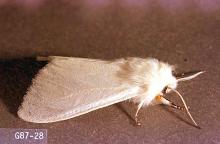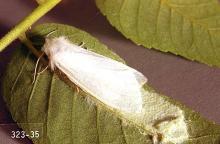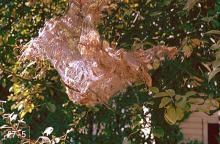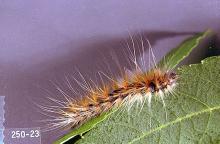Hyphantria cunea
Pest description and damage These gregarious caterpillars spin web-like tents in branch tips of deciduous trees including apple, cherry, peach, pecan, English walnut, black walnut, ash, boxelder, birch, chokecherry, elm, hickory, linden, poplar, sycamore, white oak, willow, and sometimes roses and other shrubs. The caterpillars feed on enclosed leaves as the tent fills with dead leaves and frass. As caterpillars mature, they enlarge the tent to enclose multiple branches and even entire trees. Young caterpillars are pale greenish or yellow with a dark stripe down the back and a yellow stripe along the sides. Long silky hairs arise from yellow and black tubercles. When mature, the caterpillars are over 1.25 inches in length, covered with rusty colored silky hairs. Adult moths have a 1-inch wingspan and are bright white with orange and black markings on the underside of their abdomens. Whitish moth scales cover masses of 200 to 500 greenish eggs.
Biology and life history Adults emerge over a long period in spring and lay eggs on leaves. Eggs do not hatch until late summer (late July or August). Larvae feed for 4 to 6 weeks and then drop to the ground to pupate in the duff and litter, or cells in the soil.
Pest monitoring Look for small first tents in late summer and control before significant damage is done. Early detection will also provide early indication of whether it is a bumper year for this pest. One or two nests can be ignored on healthy trees, but many nests may require early intervention with biological or other control options.
Management-cultural control
Remove tents as soon as first noticed, place in a bag and squash the nest. Do not burn tents in trees with torches, as this practice has led to house and field fires and burns to humans. Disrupt the integrity of the web by blasting it with a hose or breaking it with a long pole. Keep trees vigorous to reduce impacts.
Management-biological control
There are several natural enemies including yellowjackets, paper wasps, egg parasites and others.
Management-chemical control
See Table 2 in:





